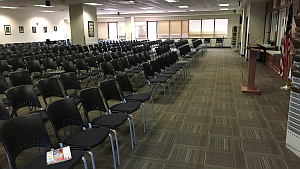 |
| https://allaccesssys.com/jury-assembly-rooms/ |
---
The fact is that in many courts, once jurors have been empaneled and leave the assembly room for courtrooms, the room is often only partially occupied as a lounge waiting room for those jurors who have not been called. And it is often a very large waiting lounge!
In the past, we have looked at different approaches for better use of these large jury rooms. One approach was to extend the use of the rooms for the public to use in the evening for community gatherings. This means that the jury room would need to be in an area where court security could easily control access. And we have also looked at courts possibly trying to schedule the use of these rooms when the juries are not convened. Again, these large spaces can restrict the use of the room.
In turn, this has led us to look at using sliding/folding partitions many of us experienced growing up in our classrooms at school or in hotel conference facilities. But one might remember that these kinds of folding screens were hard to fold and unfold. And these systems would never be satisfactory for use in a court since they did not block noise from one room to another.
The Skyfold system seems to address many of these issues (check out the short video below).
First, it is easy to use since the room dividers are raised and lowered to the ceiling with electric motors. This lets anyone use the system.
Second, the walls can be purchased with different levels of soundproofing. Many systems allow sound to be transmitted through the ceiling (even permanent walls). But the Skyfold system goes into the ceiling and blocks that sound path.
So that gets us our smaller user-friendly space. But what about the rest of a room setup? For meetings, one needs tables and chairs. The chairs will be there for the jurors, but they may or may not be easily moved. Thus, heavier chairs will need to be equipped with wheels (casters). The same with the tables.
And what about using the smaller space for training? Wi-Fi is a must. Training also requires LED screens to display the instructor’s materials that can also be on wheels (see below) and can also be connected wirelessly thanks to home entertainment systems (I would plug these screens into a wall outlet). The student’s laptop or tablet computers can be purchased with enough battery time so as to not need to be connected to electrical sockets.
Storage. I would provide an equipment closet or two so that all the training furniture and equipment can be locked at the end of the day. Or possibly this solution used in schools called “Lock n Charge”?
I hope this provides our courthouse facilities planners and operator friends with some ideas for the future? If you have such a system, please feel free to share any experience both good or bad in the comments below.

No comments:
Post a Comment